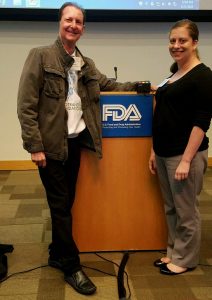Pulmonary Fibrosis Patient Spearheads Lung Transplant Foundation to Help Others

Jeffrey Goldstein and his wife Martha Austrich. (Photos courtesy of Lung Transplant Foundation)
At 3 a.m. on July 6, 2003, Miami resident Jeffrey Goldstein got a call that would change his life. Doctors at the Duke University Lung Transplant Clinic had found a lung donor match for Goldstein, who had been diagnosed with pulmonary fibrosis two years earlier.
Nearly 17 years later, the 62-year-old Floridian leads the nonprofit Lung Transplant Foundation as it funds research to fight lung rejection, provides information and guidance for new transplant recipients, and manages a mentorship network.
“We advocate and agitate on behalf of lung transplant patients,” Goldstein said.
Thousands of patients receive lung transplants every year. However, only 56% of those patients are still alive five years later, he said. Transplant failure because of chronic lung allograft dysfunction accounts for 40% of deaths after one year.
Research into bronchiolitis obliterans syndrome (BOS), the most common lung rejection condition, is a funding focus for Goldstein and his foundation. Around half of patients develop BOS within five years of their transplant, according to the American Thoracic Society.
“Every day I wake up, I’m grateful, and then I’m fearful,” Goldstein said in a phone interview with Bionews Services, publisher of this website. “Today could be the day that things change for me.”
Diagnosis: IPF
Goldstein’s journey from businessman to president of a nonprofit began in 2001, when he was CEO of a small company, Contract Resources, with five employees and annual sales of about $15 million.
While taking out the trash one night, he collapsed in his driveway, gasping for breath. He thought he was having a heart attack.
“I just laid there hoping I would survive,” Goldstein said.
Twenty minutes later, he regained the strength to walk back to the house. The next day, he made an appointment with the only doctor available — an allergist. She listened to his lungs, and Goldstein immediately knew it was bad news.
“The facial expression was all I needed to see,” Goldstein said. An X-ray at a nearby hospital confirmed he had idiopathic pulmonary fibrosis. No cure existed, and it was fatal; only a lung transplant could save him.
After the Duke University clinic accepted him, Goldstein and his wife moved from Miami to Durham, North Carolina, since transplant centers require patients to live within a three-hour drive in case a donor suddenly becomes available. The couple stayed for two years before heading back south because of his wife’s relocation contract with Novartis.
Venture philanthropy
After the transplant, Goldstein said, he had nothing to do. He lost his business, and his friends were still working full-time.
In 2005, he connected with the now-defunct Transplant Foundation in Miami and helped with fundraising. Goldstein managed a marketing campaign, which included then-NBA player Alonzo Mourning, for Florida state license plates. A portion of every purchase went to the foundation. Four years later — shortly after Goldstein was elected president of the organization — he was diagnosed with chronic myeloid leukemia.
However, that diagnosis didn’t stop Goldstein either. While undergoing chemotherapy, he built his foundation from the ground up.
Rather than fund transplants, Goldstein wanted to push research that would reduce post-transplant death and address the root cause. That decision led him to establish the Lung Transplant Foundation in April 2008.
With his business background, Goldstein added venture philanthropy to the foundation’s fundraising playbook in 2015. By providing seed funding for a company in its early stages, the foundation receives a return on investment.
So far, the foundation’s first and only venture philanthropy-funded project is with Paragonix Technologies, a company that builds transportation devices for solid organ transplants. The company’s LUNGguard preserves donor lungs for up to eight hours.
The foundation is also looking at two potential projects that deal with diagnostic devices for transplant patients. In addition, Goldstein is involved with a company that aims to develop an anti-microbial product to prevent infections that cause lung rejection.
Improving the survival odds
While Goldstein and his foundation are early in their venture philanthropy, he hopes this kind of fundraising can provide a sustained source of income in the future. More recently, the foundation has been considering research projects such as a 3D printing model that prevents acute rejection after transplant and also treats BOS.
The odds of living five years after a lung transplant remain just over 50%, a statistic Goldstein believes he can improve by better preparing patients emotionally for a transplant. That’s why he started a mentorship network in 2018.
“Being prepared mentally for every part of it is really important to the success of your transplant, both physically and emotionally,” Goldstein said.
The network is named after Joseph J. Carter, who died 11 years ago at the age of 38 from congenital lung failure and is survived by his wife, Shari Carter, and two young boys. Shari started a foundation in honor of her husband, then disbanded it and donated its funds to the Lung Transplant Foundation to help build its mentorship program.
While Goldstein has helped many lung transplant recipients, he connected with his own donor family only recently, 15 years after his transplant.
“It’s an overwhelming feeling of gratefulness,” Goldstein said of their first encounter. “You are meeting loved ones who had the generosity and the charity in them to donate their loved one’s organs.”







